There are 17 different types of turtles in Japan. Whether you are the proud owner of one or live in Japan and want to know what turtles roam the country, knowing what turtles are native and can be found in Japan is an interesting topic.
Turtles are quite a popular pet choice in Japan mostly because of their beliefs. In Japanese, the word for turtle is ‘kame’.
Japanese people believe that turtles are a symbol of luck, protection, and wisdom. Typically, turtles are a huge symbol of longevity due to their slow movements and long life.
In traditional Japanese beliefs, tortoises are known as a refuge of the World Mountain, a place for immortals. They symbolize good luck, support, and longevity.
As in many parts of the world, turtles and tortoises have also been used as food or medicine in Japan.
In Japan, you can find about 12 species of turtles and 5 species of sea turtles.
In terms of legality, turtles are legal when they have been imported under CITES rules and regulations. Native species are not legal to sell or catch.
Turtles are classified as an invasive species in Japan since they eat all the fish, bird, and weed stocks. They are also biting through fishermen’s nets, wreaking havoc in the fishing industry.
Japan is known as the most popular importer of tortoises in the world pet trade.
In Japan, it is honestly hard to tell if the turtles for sale were illegally caught or imported legally, but the animal is legal to keep as a pet and is typically sold without needing a license.
Now that you know a little more about turtles and their meaning to Japanese people as well as their legality in the country, here is our list of turtles in Japan:
1. Japanese Pond Turtle

- Experience Level: Beginner
- Family: Geoemydidae
- Scientific Name: Mauremys japonica
- Common Names: Japanese Stone Turtle
- Adult Size: about 5 to 7 inches
- Lifespan: 20 years
These turtles will typically have a yellow, dark brown, or black carapace with an olive-brown head. Females will typically be larger than their male counterparts but males have longer tails.
These omnivorous turtles are great beginner turtles and have interesting looks. They don’t require too much care and can eat a large variety of foods.
They like cooler temperatures than most pet turtles and can adapt well to the cold, which Japan can get sometimes.
2. Red-eared Slider

- Experience Level: Beginner
- Family: Emydidae
- Scientific Name: Trachemys scripta elegans
- Common Names: Slider Turtle, Red-eared Turtle, Red-eared Terrapin, Red-eared Slider Turtle, and Water Slider Turtle
- Adult Size: 6 to 8 inches
- Lifespan: 20 to 40 years
Fun fact time: Leonardo from the Teenaged Mutant Ninja Turtles is supposed to be a Red-eared Slider!
This aquatic turtle is a great swimmer and will need a lot of space to do so; the bigger the turtle, the bigger the tank!
They can be identified by their bright yellow stripes and a signature patch of red just behind their eyes. It is also, however, not uncommon to find some red-eared sliders without this patch.
They have webbed feet that are perfect for maneuvering around in the water. Red-eared sliders are carnivorous while young but shift to an omnivorous diet as they grow into adulthood. When feeding your pet slider, you will want to give it a diet that is basically half vegetation with leafy greens, green beans, or carrots. You also want to feed them a 25% commercial diet, with the other quarter being animal protein.
A commercial diet will consist of turtle pellets or trout chow, whereas animal protein can be anything from live feeder fish, earthworms, aquatic snails, and crickets!
3. Common Snapping Turtle
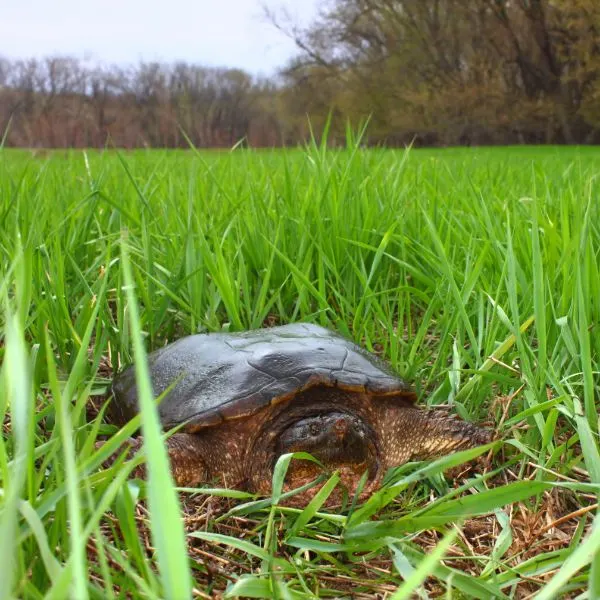
- Experience Level: Intermediate to Expert
- Family: Chelydridae
- Scientific Name: Chelydra serpentina
- Common Names: Snapping Turtle
- Adult Size: 8 to 20 inches
- Lifespan: 30 to 50 years
These guys can start out pretty comfortably small at a young age, but can also quickly grow to be very large turtles.
If you want one of these beauties as a pet, you will have to know your way around snappy turtles; hence the name!
Snapping turtles can usually be identified by their little beak or sharp nose. Their shell color will usually range from tan to a dark, almost-black brown. Their limbs and tails show off a peek of yellow, whereas their heads will usually be a dark olive or black.
These turtles will hiss and snap if they are feeling threatened. They can be quite aggressive and are prone to snapping when being handled so you will have to give them time to calm down.
You will need to fill your aquarium with enough aquatic vegetation or logs for these shy guys to hide behind. They will eat almost anything including aquatic vegetation, amphibians, freshwater fish, small mammals like birds, bloodworms, shrimps, snails, cooked lean meats, crickets, mealworms, and earthworms!
Snapping turtles barely bask, but they will float up to the surface of the water to warm up, so you will want to still have a UV light available for them to do their own version of “basking” in.
Snapping turtles may not be the most cuddly pets, but they are fascinating and fun to observe for anyone who has more experience handling and caring for more aggressive, territorial turtles!
4. Chinese Pond Turtle

- Experience Level: Beginner to Intermediate
- Family: Geoemydidae
- Scientific Name: Mauremys reevesii
- Common Names: Reeves’ Turtle, Chinese Three-Keeled Pond Turtle
- Adult Size: 6 to 9 inches
- Lifespan: 10 to 20 years
These lively turtles can be rewarding pets since they are low maintenance and are quite active. They are a great beginner pet turtle that makes for a good introduction to turtle keeping.
These guys have a brown carapace with grey or olive green bodies that have yellow markings on the side of their faces.
They can be found in Japan, but also China, Taiwan, and also Korea.
5. Chinese Box Turtle

- Experience Level: Beginner
- Family: Geoemydidae
- Scientific Name: Cuora flavomarginata
- Common Names: Yellow Margined Box Turtle, Golden-headed Turtle
- Adult Size: 5 to 12 inches
- Lifespan: 25 to 40 years
These turtles have a yellow marking on each side of their pale green heads. Their necks may be an apricot or yellow coloration.
The majority of the population of these turtles come from Taiwan, where they are traditionally used for folk medicine or are eaten.
They are a loveable and smart species that can make great generational pets due to their longer lifespan.
This species will need a maintained humidity of around 60% to 70% during the day and their temperatures should never drop below 75 degrees Fahrenheit.
While this species is omnivorous, they have a large preference for vegetables. While they will enjoy a few live preys as protein, vegetables are a staple in their diet.
They are semi-aquatic and can thrive best in an outdoor enclosure that has a small pond. However, they can be housed indoors, just make sure you give them the space and a nice aquarium with a nice basking rock.
6. Indochinese Box Turtle

- Experience Level: Beginner
- Family: Geoemydidae
- Scientific Name: Cuora galbinifrons
- Common Names: Vietnamese Box Turtle, Flowerback Box Turtle
- Adult Size: 5 to 8 inches
- Lifespan: up to 38 years
These turtles’ carapaces are high-domed with alternating dark brown and pale yellow or cream coloration or striping. They also have a cream-colored chin with a pointed head and a short, yellow-grey snout.
In nature, they like to hide in high-altitude woodlands and can be found in Vietnam, Laos, China, and also sometimes in Cambodia.
They get the name “Flowerback” from the intricate patterns on their shell that might sometimes replicate flowers.
This species is critically endangered, which is why the information on them is somewhat limited.
7. Ryukyu Black-breasted Leaf Turtle

- Experience Level: Intermediate
- Family: Geoemydidae
- Scientific Name: Geoemyda japonica
- Common Names: Ryukyu Leaf Turtle, Okinawa Black-breasted Leaf Turtle
- Adult Size: 6 inches
- Lifespan: 20 years
These turtles have a dark orange, red, copper, or tan coloration on their carapace but typically look brown in color. Their plastron is almost entirely black, which is where they get their name, “black-breasted”.
This species of turtle also have axillary scutes, which can be found just behind each of their front limbs.
They are endemic to Okinawa, Kume, and Tokashiki islands, where they can only be found in or around dense forests.
8. Yellow Pond Turtle
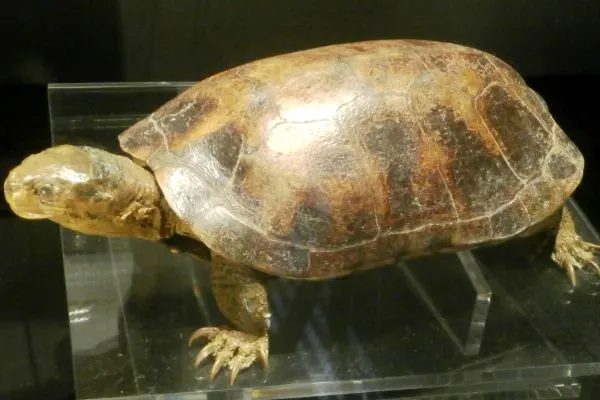
- Experience Level: Intermediate
- Family: Geoemydidae
- Scientific Name: Mauremys mutica
- Common Names: Asian Yellow Pond Turtle
- Adult Size: 7 to 8 inches
- Lifespan: 20 to 22 years
This species of turtle looks broad and yellow overall with some greys and browns here and there. Their plastron is yellow or orange with some black blotched edges.
They are endemic to Eastern Asia where they can be found in Laos, Vietnam, China, Taiwan, Hainan, and the Ryukyu Islands. Their populations in Japan are mostly due to import from Taiwan.
The Yellow Pond Turtle is considered a critically endangered species. Most of their trade is intended for human consumption, the pet trade, and traditional medicine.
There are also environmental issues like habitat loss and water pollution which impact their conservation status.
9. Chinese Softshell Turtle
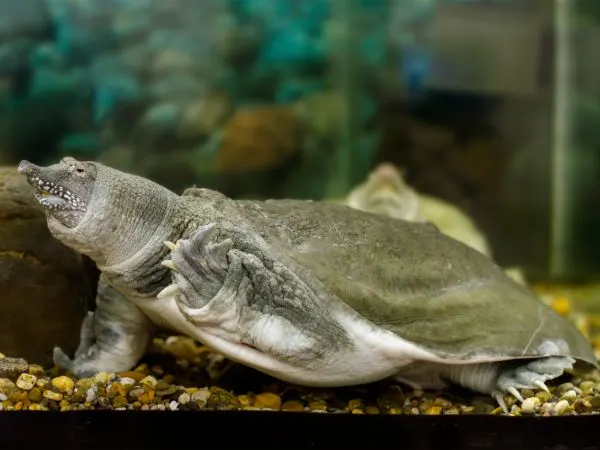
- Experience Level: Intermediate
- Family: Trionychidae
- Scientific Name: Pelodiscus sinensis
- Adult Size: 4.5 to 10 inches
- Lifespan: 30 to50 years
Chinese Softshells are typically pale or olive green with rounded carapaces and a cream-colored plastron.
These aquatic turtles are endemic to China, however, there have been some escapees that have somehow gotten into other parts of Asia, to Spain, Brazil, and Hawaii.
In China and Taiwan, along with other parts of Asia, these turtles are known as a delicacy for a healthy “tonic”.
These turtles are very active and might become aggressive with tank mates. They can become stressed around other turtles so they are best when left alone.
They love to hunt and are hardy turtles, making them a great pet for those who might already have some experience caring for turtles in the past. They need the proper care to thrive in captivity.
10. Big-Headed Turtle

- Experience Level: Intermediate to Expert
- Family: Platysternidae
- Scientific Name: Platysternon megacephalum
- Adult Size: 15.7 inches
- Lifespan: 20 years
While these are not recommended as pets due to their snappy demeanor and size, they are very interesting turtles.
They are oddly shaped and have a somewhat flat brown or tan shell with a grey, tan, or cream-colored body. As their name suggests, they have a larger head in comparison to other turtles which looks interesting.
They are native to both Southeast Asia and parts of southern China.
11. Alligator Snapping Turtle

- Experience Level: Intermediate to Expert
- Family: Chelydridae
- Scientific Name: Macrochelys temminckii
- Adult Size: 15 to 30 inches
- Lifespan: 20 to 70 years
These awesome, Godzilla-looking turtles can grow to be pretty large.
They are typically dark brown and tan all over with jagged carapaces and a pointy mouth. They really do resemble almost a Godzilla-like appearance.
They are native to many parts of Asia and have been known to kill whole alligators! You don’t want to mess with them.
This is why they are not typically known as being pet-friendly as they can get quite vicious.
12. Northern River Terrapin
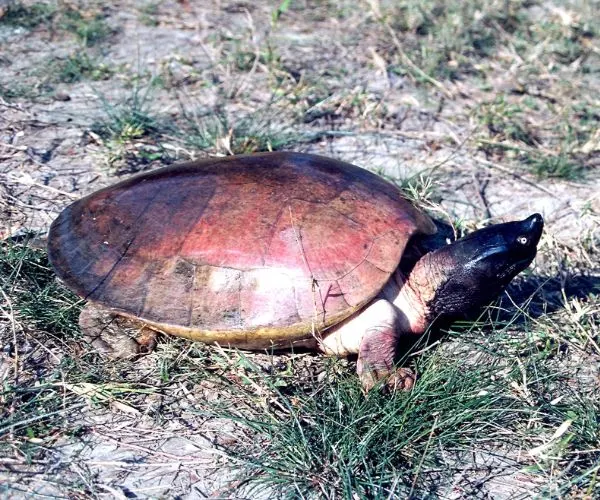
- Experience Level: Beginner to Intermediate
- Family: Geoemydidae
- Scientific Name: Batagur baska
- Adult Size: 15.5 to 23.6 inches
- Lifespan: Anywhere from 30 to 80 years
These guys are native to Southeast Asia and are typically harvested for their meat and traded in the exotic pet trade.
They are classified as Critically Endangered according to the IUCN.
They are typically darker in color with a brown or almost black carapace. Some individuals will have a red body, a black head, and a cream-grey underside whereas others might be grey or brown on top and tan underneath.
Sea Turtles in Japan
Here are some sea turtles you might find in Japan:
13. Green Sea Turtle

- Scientific Name: Chelonia Mydas
- Family: Cheloniidae
- Adult Size: 3 to 4 feet
- Weight: 300 to 400 pounds
- Lifespan: 80 to 100 years
- Conservation Status: Endangered
- Habitat: Tropical and subtropical waters in bays and shores by the coastline; anywhere with seagrass beds
- Clutch Size: 110 to 115 eggs; Nesting 2 to 5 times per season
- Food: Primarily herbivorous, eating seagrass and seaweed, sometimes algae. Sometimes younger green sea turtles will feed on worms, aquatic insects, or small crustaceans.
- Appearance: They have nonretractable, small heads and a heart-shaped, brown carapace. They will wear a greenish hue on their scaley skin, will have a cream-colored underside, and beady eyes.
- Area: Nansei and Ogasawara Islands.
14. Loggerhead Sea Turtle
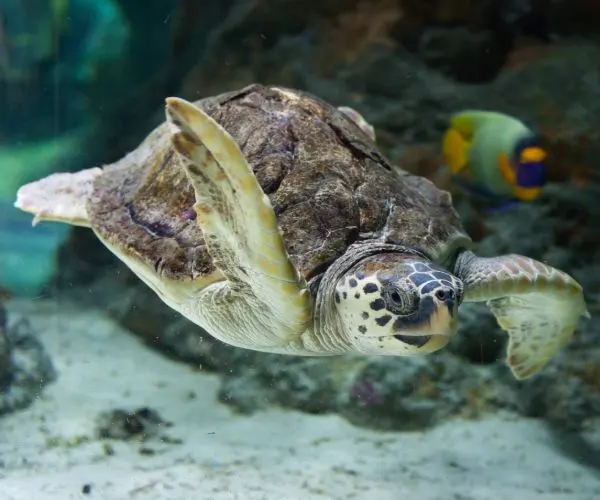
- Scientific Name: Caretta caretta
- Family: Cheloniidae
- Adult Size: between 35 inches and 3 feet
- Weight: 154 pounds
- Lifespan: 70 to 80 years
- Conservation Status: Endangered
- Habitat: Shallow, subtropical coastal regions
- Clutch Size: 100 to 125 eggs; nesting 4 to 5 times per season
- Food: Carnivorous; they will eat clams, conches, and crabs!
- Appearance: Hard-shelled turtles with a reddish-brown color, a yellow underbelly, and long flippers. They have a large head with a defined jaw.
- Area: Honshu, Shikoku, Kyushu, and the Nansei Islands.
15. Hawksbill Sea Turtle
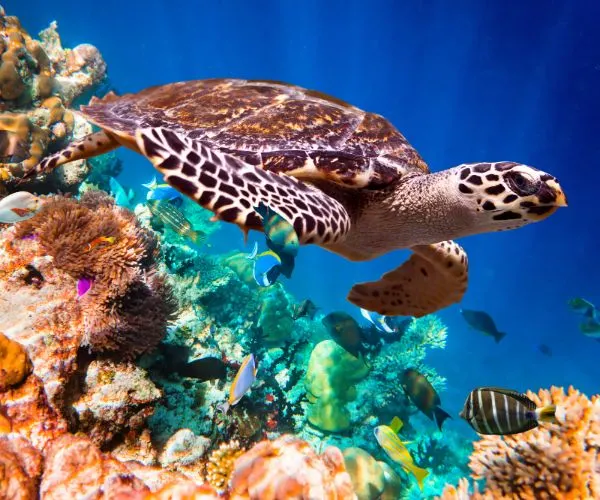
- Scientific Name: Eretmochelys Imbricata
- Family: Cheloniidae
- Adult Size: 30 to 35 inches
- Weight: between 100 to 155 pounds
- Lifespan: About 30 to 50 years
- Conservation Status: Critically Endangered
- Habitat: Tropical, rocky waters, mangroves, lagoons, or near tropical coral reefs.
- Clutch Size: Anything from 140 to 200 eggs; Nesting about 4 times each season or every 2 weeks
- Food: Omnivorous; They will feed on sea urchins, jellyfish, mollusks, marine algae, and sponges!
- Appearance: They get their name from their unique beak-like mouths, which are similar to hawks. They will show off an elongated, oval-shaped, amber-colored, shell that has unique patterns on it. Their also amber flippers have claws at the “elbows” of them as well!
- Area: The Ryukyu Archipelago.
16. Leatherback Sea Turtle

- Scientific Name: Dermochelys Coriacea
- Family: Dermochelyidea
- Adult Size: About 6 to 7 feet
- Weight: Between 1200 and 1450 pounds
- Lifespan: 30 years
- Conservation Status: Vulnerable
- Habitat: They like warm waters and can be found in every ocean except the Arctic. They will inhabit calm, shallow lagoons or bays. They love to nest on sand, sloping beaches with good vegetation.
- Clutch Size: 100 to 110 eggs.
- Food: Mainly jellyfish but sometimes some fish and other marine creatures.
- Appearance: It is the only sea turtle that lacks a hard shell, which is dark grey to black in color, sometimes showcasing scattered white spots or blotches. Their dark carapace is elongated and flexible with long ridges running down its length.
- Area: They often pass by Japan offshore
17. Olive Ridley Sea Turtle
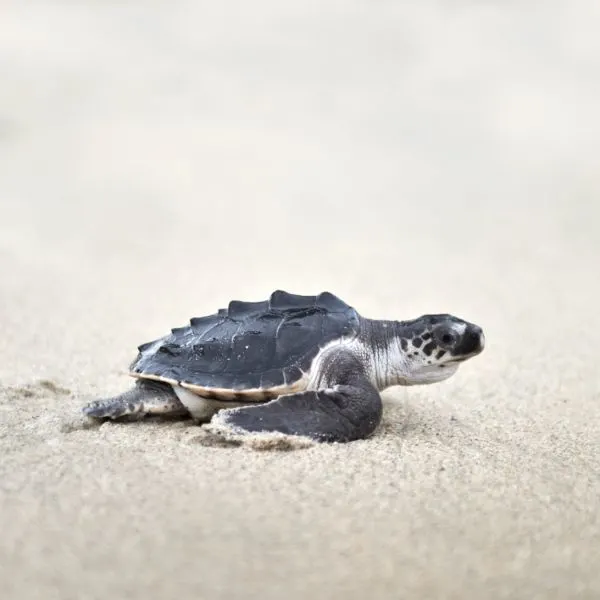
- Scientific Name: Lepidochelys olivacea
- Family: Cheloniidae
- Adult Size: 2 feet
- Weight: up to 100 pounds
- Lifespan: 50 years
- Conservation Status: Vulnerable
- Habitat: Open-ocean, warm waters. Scattered across thePacific, Atlantic, and Indian oceans.
- Clutch Size: 110 eggs
- Food: Omnivorous;Fish, shrimp, mollusks, tunicates, lobster, crabs, and algae.
- Appearance: Grey-olive green with a heart-shaped carapace and one or two claws.
- Area: They often pass by Japan offshore
Conclusion
Whether you live in Japan or are interested to know what turtle species you can find there, we hope this article brought you some insight and helped answer your questions about what turtles are native to Japan.
Japan has many interesting beliefs and histories about the turtle, which makes it even more interesting to see how important they are as pets to Japanese society.
Leave us a comment down below about your thoughts on the turtles of Japan!
References
https://en.wikipedia.org/wiki/Spirit_turtle
